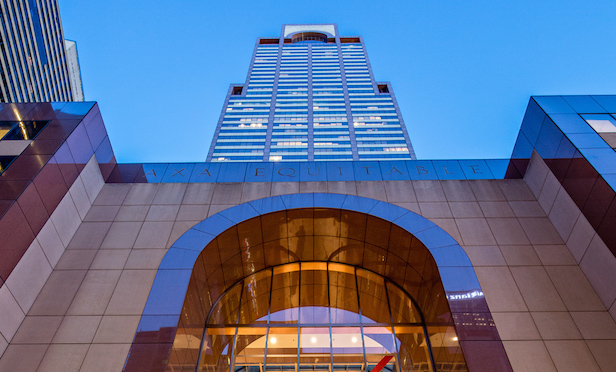 The $1.9-billion sale of the AXA Equitable Building at 787 Seventh Ave. in Midtown Manhattan was the year’s largest office deal.
The $1.9-billion sale of the AXA Equitable Building at 787 Seventh Ave. in Midtown Manhattan was the year’s largest office deal.
LOS ANGELES—While Real Capital Analytics reports that multifamily led all other property sectors for investment sales in 2016, the second consecutive year in which this was the case, former front-runner office was hardly an also-ran last year. CBRE’s Americas Office Trends report, issued late last week, says that total volume for office reached $141.7 billion, the second highest since 2007, although 6% below the record level established the year before.
If volume was off somewhat from the year prior, then conversely prices were up on a year-over-year basis. Citing preliminary estimates of the Moody’s RCA CPPI, CBRE says office sales prices rose by an average of 10% compared to 2015.
Where the money came from, and where it went, changed over the course of the year. CBRE’s report cites “an increased appetite for risk” among investors last year, as CBD core/stabilized volumes in non-major metro areas grew by 27% for ’16. RCA adds that investors also took on more asset risk moving to more suburban core and suburban value-add in the six major metro areas. Even so, with nearly one-sixth of the national tally, Manhattan garnered the highest tally of office investment with $22.7 billion.
Meanwhile, cross-border investments in the office sector grew by 5% Y-O-Y to $31.5 billion, although volume decreased by 20% quarter-over-quarter in the fourth quarter. Germany, Canada, China, South Korea and Qatar represented the top five sources of inbound capital in the office sector, CBRE says.
The investment sales environment for office wouldn’t be nearly as healthy if the fundamentals weren’t there to support it. CoStar Group reported last week that steady growth in office-using employment over the past few years and rising demand from major employers for a diminishing supply of newer space “have combined to create a fertile environment for new office construction, and developers are ready to deliver.” 2017 is likely to represent the peak in the cycle for the delivery of new office projects, according to CoStar Portfolio Strategy forecasts. CoStar notes that US office vacancy has continued to steadily decline, moving from 10.7% in ‘15 to 10.4% in ‘16. Vacancies are expected to hold fast at 10.3% this year amid ongoing demand for existing space from tenants. The big news for office this year is that “we’re expecting a 55% spike in construction deliveries, increasing from 58 million square feet of new office space in 2016 to over 90 million square feet this year,” says Walter Page, CoStar’s portfolio strategy director of research/office. “While some of those will be projects that were pushed back from last year, we’re just at that point in the market cycle where it’s time for new supply.”
Naturally, macroeconomic forces come into play in determining the course of a commercial property sector that’s so dependent on jobs. “The outcome of the US presidential election has added some uncertainty to the Americas economic outlook,” according to CBRE’s report. “However, the increasingly tight and expensive labor market will likely have a greater impact on the overall office market in 2017.”
That’s the case even as the status quo for economic growth is likely to prevail, says Green Street Advisors in a report on the sector. “The ‘good ole days’ of 3% to 5% annual real GDP growth seems a distant memory, as the US economy fell short of the 3% bogey for the 11th straight year in ’16,” according to Green Street Advisors. “While President Trump is setting his sights on 4% GDP growth, a ‘New Normal’ growth rate in the low-to-mid 2% range seems more likely. This pace of economic growth should still be strong enough to drive decent office demand.”

















 Copyright © 2024 ALM Global, LLC. All Rights Reserved.
Copyright © 2024 ALM Global, LLC. All Rights Reserved.